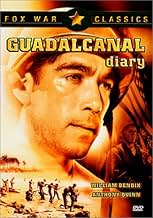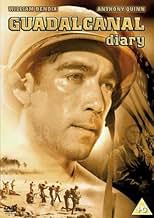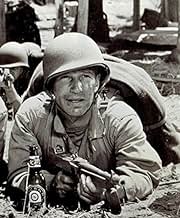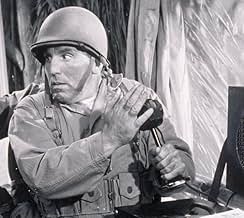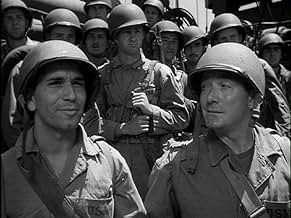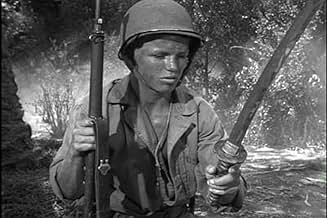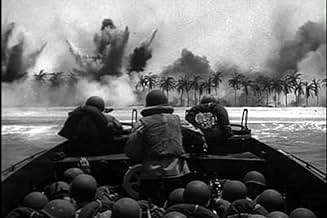IMDb RATING
6.7/10
2.4K
YOUR RATING
The story of a large U.S. Marines invasion task force bound for Guadalcanal in the Solomon Islands in 1942.The story of a large U.S. Marines invasion task force bound for Guadalcanal in the Solomon Islands in 1942.The story of a large U.S. Marines invasion task force bound for Guadalcanal in the Solomon Islands in 1942.
- Awards
- 1 win total
Eddie Acuff
- Pvt. Tex Mcllvoy
- (uncredited)
Warren Ashe
- Col. Morton
- (uncredited)
Martin Black
- Marine
- (uncredited)
Marion Carl
- Marine Pilot
- (uncredited)
Harry Carter
- Dispatch Officer
- (uncredited)
Tom Dawson
- Captain
- (uncredited)
Featured reviews
Guadalcanal is the second largest island (after Bougainville) of the Solomons and largest of the Solomon Islands Protectorate southwest Pacific...
During World War II it was the scene of bitter land and sea fighting between U. S. and Japanese forces...
On August 1942, the U.S. Marines, in the Allies' first major offensive in the Pacific, seized a Japanese airfield, Henderson Field, on the island...
On November, in a naval engagement, the Allies prevented the Japanese from landing reinforcements... By February 1943 the Japanese, badly outnumbered, were forced to evacuate Guadalcanal and by the end of the year they were on the defensive in their last stronghold in the Solomons, Bougainville Island...
"Guadalcanal Diary" is based on the best-selling book by war correspondent Richard Tregaskis... It follows the career of a platoon of Marines from Pre-landing shipboard briefings through two months slow murderous fighting in the taking of the South Sea jungles...
The film gives a realistic view of the hardships of war, and has its moments... Perhaps the most touching scene is at the climax when the tired veterans watch the fresh, green troops marching past them... The feeling is one of a continuous hard effort... The impudent newcomers have yet to face the revolting horrors that an American soldier is subjected to... Certainly, they will fight as well as those before them, however, we cannot but help feeling sad for those who will never return...
The film reveals the hard life in camps, shelters, patrols, hospitals, beaches and jungles in absolute reality... It is terse, violent, close in atmosphere and technique to "Wake Island" (1942).
During World War II it was the scene of bitter land and sea fighting between U. S. and Japanese forces...
On August 1942, the U.S. Marines, in the Allies' first major offensive in the Pacific, seized a Japanese airfield, Henderson Field, on the island...
On November, in a naval engagement, the Allies prevented the Japanese from landing reinforcements... By February 1943 the Japanese, badly outnumbered, were forced to evacuate Guadalcanal and by the end of the year they were on the defensive in their last stronghold in the Solomons, Bougainville Island...
"Guadalcanal Diary" is based on the best-selling book by war correspondent Richard Tregaskis... It follows the career of a platoon of Marines from Pre-landing shipboard briefings through two months slow murderous fighting in the taking of the South Sea jungles...
The film gives a realistic view of the hardships of war, and has its moments... Perhaps the most touching scene is at the climax when the tired veterans watch the fresh, green troops marching past them... The feeling is one of a continuous hard effort... The impudent newcomers have yet to face the revolting horrors that an American soldier is subjected to... Certainly, they will fight as well as those before them, however, we cannot but help feeling sad for those who will never return...
The film reveals the hard life in camps, shelters, patrols, hospitals, beaches and jungles in absolute reality... It is terse, violent, close in atmosphere and technique to "Wake Island" (1942).
War correspondent Richard Tregaskis's memoir of the battle for the strategic island of Guadalcanal provides the basis of this film with a solid cast of players. Tregaskis himself is played unnamed in the film by Reed Hadley, who's rich narrative voice greatly enhances the film.
Guadalcanal Diary unfortunately has not aged well. It was made the year after Guadalcanal, together with its key airfield Henderson Field was finally cleared of Japanese. It was a slow, steady war of attrition, on both land and sea. While this film concerns the Marines on the island, at sea our navy was battling with the Japanese Navy in what was euphemistically called 'the slot' which was a channel that bisected the Solomon chain neatly in half. Our Marines dealt not only with the Japanese on the ground, but from Naval bombardment from the Japanese Fleet whenever they snuck in. The Japanese positions were in the jungle and further in land and were less affected by off shore shelling from us.
All the types you expect from World War II are there, the tough Marine sergeant Lloyd Nolan, the Marine from Brooklyn, where else, William Bendix, the young recruit, Richard Jaeckel in his first film playing a teenager when he actually was one. Preston Foster plays the Catholic chaplain, a wise and compassionate fellow who once played football for Notre Dame. It's a page out of Pat O'Brien's Father Duffy portrayal from The Fighting 69th and Foster is the best one in the film.
Sad to say that the Marines do refer to the Japanese as less than human on a few occasions. It's why the film doesn't age well, especially after Clint Eastwood's latest films about the Pacific Theater.
Guadalcanal Diary still is a good film for those who are fans of World War II films made in the World War II years.
Guadalcanal Diary unfortunately has not aged well. It was made the year after Guadalcanal, together with its key airfield Henderson Field was finally cleared of Japanese. It was a slow, steady war of attrition, on both land and sea. While this film concerns the Marines on the island, at sea our navy was battling with the Japanese Navy in what was euphemistically called 'the slot' which was a channel that bisected the Solomon chain neatly in half. Our Marines dealt not only with the Japanese on the ground, but from Naval bombardment from the Japanese Fleet whenever they snuck in. The Japanese positions were in the jungle and further in land and were less affected by off shore shelling from us.
All the types you expect from World War II are there, the tough Marine sergeant Lloyd Nolan, the Marine from Brooklyn, where else, William Bendix, the young recruit, Richard Jaeckel in his first film playing a teenager when he actually was one. Preston Foster plays the Catholic chaplain, a wise and compassionate fellow who once played football for Notre Dame. It's a page out of Pat O'Brien's Father Duffy portrayal from The Fighting 69th and Foster is the best one in the film.
Sad to say that the Marines do refer to the Japanese as less than human on a few occasions. It's why the film doesn't age well, especially after Clint Eastwood's latest films about the Pacific Theater.
Guadalcanal Diary still is a good film for those who are fans of World War II films made in the World War II years.
I can't be offended by the truth, and the truth is, GIs called the enemy in the South Pacific "Japs," "Slant-eyes," and a lot worse. If that offends anyone, then why watch a film that you know is about a bloody WWII battle, where passions were running high? After the Marine shoots the Japanese sniper out of the tree, would it have been less offensive if he would have said, "Well, I just dispatched another one of the Asian enemy." Really! I can just imagine what someone would say in the heat of battle. It'd be a hell of a lot more descriptive than "Slant-eye."
As for the nameless reviewer who criticized the scene wherein the GI did not get mail, I can tell you first hand, that there were fewer sights more pathetic than the guys standing there after mailcall without a single letter in their hand. It was hard to watch. We all felt for those guys. You knew what they were going through, yet you couldn't do a damn thing to help them. I know how I felt when days went by without a letter from home--from ANYONE. Being in combat in a foreign land must have made it exponentially worse. I would bet that the reviewer who made that criticism never spent one day in his country's service.
As for the nameless reviewer who criticized the scene wherein the GI did not get mail, I can tell you first hand, that there were fewer sights more pathetic than the guys standing there after mailcall without a single letter in their hand. It was hard to watch. We all felt for those guys. You knew what they were going through, yet you couldn't do a damn thing to help them. I know how I felt when days went by without a letter from home--from ANYONE. Being in combat in a foreign land must have made it exponentially worse. I would bet that the reviewer who made that criticism never spent one day in his country's service.
This is one of the better (and most topical) of Hollywood’s wartime efforts, but which seems to have been largely overlooked among the surplus of such films – possibly because it was helmed by journeyman director Seiler.
Still, the handling is entirely professional and the film makes the most of a good script by Lamar Trotti – peopled with believable characters ably portrayed by a fine cast (Preston Foster, Lloyd Nolan, Richard Conte, Anthony Quinn, Richard Jaeckel). The requisite comic relief provided by William Bendix and Lionel Stander is slightly overstated…but, then, Bendix delivers the film’s most moving speech towards the end.
The film – unavoidably jingoistic but, at the same time, realistic i.e. thankfully free of gung-ho heroics – balances taut action sequences (culminating in the so-called “Great Offensive”) with a handful of undeniably powerful, lingering images (particularly the line-up of dead U.S. marines ambushed on a beach by the devious Japanese forces). I’ll be following this with Cornel Wilde’s well-regarded BEACH RED (1967), which also deals with WWII combat in the Pacific; besides, I also own – but have yet to watch – the R2 DVD of Lewis Milestone’s contemporaneous THE PURPLE HEART (1944), which tackles similar events from a unique perspective.
Still, the handling is entirely professional and the film makes the most of a good script by Lamar Trotti – peopled with believable characters ably portrayed by a fine cast (Preston Foster, Lloyd Nolan, Richard Conte, Anthony Quinn, Richard Jaeckel). The requisite comic relief provided by William Bendix and Lionel Stander is slightly overstated…but, then, Bendix delivers the film’s most moving speech towards the end.
The film – unavoidably jingoistic but, at the same time, realistic i.e. thankfully free of gung-ho heroics – balances taut action sequences (culminating in the so-called “Great Offensive”) with a handful of undeniably powerful, lingering images (particularly the line-up of dead U.S. marines ambushed on a beach by the devious Japanese forces). I’ll be following this with Cornel Wilde’s well-regarded BEACH RED (1967), which also deals with WWII combat in the Pacific; besides, I also own – but have yet to watch – the R2 DVD of Lewis Milestone’s contemporaneous THE PURPLE HEART (1944), which tackles similar events from a unique perspective.
This is a tremendous World War II film with amazing performances. The director, Lewis Seiler, and the writer of the screenplay, Lamar Trotti, must have really been on their toes to come up with this little gem from a book by Richard Tregaskis. The quality of "Guadalcanal" is amazing from the special effects and location shots to the cinematography and the dialogue. Sometimes less is more and this movie demonstrates that in portraying the violence of war realistically without being extremely graphic. The only minor flaw I saw in the special effects was when a few soldiers were killed by grenades or bombs and they seemed to fall over from the blast a tad bit too quickly. This movie uses an ensemble cast of actors to tell the story of a platoon of U.S. marines sent to Guadalcanal to fight the Japanese in the South Pacific Ocean. The focus is not as much on the fighting and battles as it is on the men themselves in the context of war, although there are several terrific scenes of fighting and skirmishes that propel the movie along at an excellent pace. "Guadalcanal" is in glorious black and white film and is crisp and clear. Many scenes from the movie are so vivid that they have lingered in my mind long after watching the movie. I can recall vividly the palm trees on the beach, the sound of the men singing, the men lounging on the deck of the ship, Japanese soldiers being blown up in a cave and falling out of trees, the faces and expressions of the men and on and on. This movie not only stood up to a second viewing but also seemed even better the second time around. I can't praise the actors enough who breathe life into this movie and who make their characters so easy to get to know that this sixty year old movie seems like it was made yesterday. Watch this movie and see how these men respond to battle in "Guadalcanal." It's an experience not to be missed. I highly recommend it and give it a 92/100. I purchased the DVD for my collection.
Did you know
- TriviaMarine Corps Capt. Marion Carl, a multi-ace (18.5 air victories), makes an appearance as a Marine Corps pilot. Capt. Carl wears his baseball cap with the bill pointed skyward and makes the comment, "Don't look now, fellas, but a truck of gas just came on the field." Capt. Carl was a survivor of the Battle of Midway and the air campaign for Guadalcanal in 1942. He was awarded 2 Navy Crosses for his actions at Midway and Guadalcanal. Sadly, on June 28, 1998, he was murdered in his Oregon home by a home intruder.
- GoofsWhen Japanese snipers hid in the tops of trees, they tied themselves into their positions. They did not fall out of the trees when shot.
- Quotes
Cpl. Aloysius T. 'Taxi' Potts: [In dugout waiting out a heavy artillery barrage] I don't mind the one with my name on it. It's the one that says, 'To whom it may concern' that I don't like.
[after the barrage increases]
Cpl. Aloysius T. 'Taxi' Potts: They're throwing everything at us but the kitchen stove.
Gunnery Sgt. Hook Malone: [after an even louder explosion] That's the stove now!
- Crazy creditsThe film's opening prologue in the preface of a book states: A new chapter in the history of America by a correspondent who landed on Guadalcanal with the first detachment of United States Marines.
- ConnectionsEdited into Tarawa, tête de pont (1958)
- SoundtracksMarine Hymn
(uncredited)
Music by Jacques Offenbach from "Geneviève de Brabant"
Played during the opening credits and occasionally in the score
- How long is Guadalcanal Diary?Powered by Alexa
Details
- Runtime
- 1h 33m(93 min)
- Color
- Aspect ratio
- 1.37 : 1
Contribute to this page
Suggest an edit or add missing content


